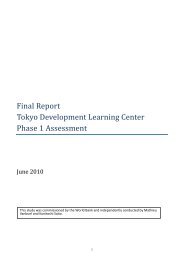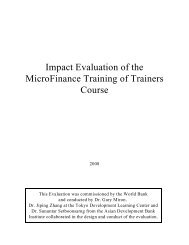Prof. Masako Ii 1 (Japan) - Tokyo Development Learning Center
Prof. Masako Ii 1 (Japan) - Tokyo Development Learning Center
Prof. Masako Ii 1 (Japan) - Tokyo Development Learning Center
You also want an ePaper? Increase the reach of your titles
YUMPU automatically turns print PDFs into web optimized ePapers that Google loves.
Health Care Reform in Asia:<br />
Key issues in <strong>Japan</strong>ese Healthcare<br />
<strong>Prof</strong>essor <strong>Masako</strong> <strong>Ii</strong><br />
Hitotsubashi University<br />
masako@econ.hit-u.ac.jp<br />
3 December 2012<br />
1<br />
KDI School of Public Policy and Management,<br />
The World Bank,<br />
<strong>Tokyo</strong> <strong>Development</strong> <strong>Learning</strong> <strong>Center</strong>
“The Economics of Public Health Care Reform in<br />
Advanced and Emerging Economies”, IMF (2012)<br />
“The use of market mechanisms in Germany<br />
and <strong>Japan</strong> is an important factor explaining the<br />
low excess cost growth observed in these<br />
countries – both of which score relatively high<br />
in the indices for choice of insurer, choice of<br />
provider, and private provision.”
“Health Care Systems: Efficiency and Institutions”<br />
OECD Economic Department (2010)<br />
“Although estimates of health care spending<br />
efficiency should not be taken at face value,<br />
Australia, Korea, <strong>Japan</strong> and Switzerland<br />
perform best in transforming money into<br />
health outcomes.”
The Economist, September 10, 2011<br />
“<strong>Japan</strong>’s health-care system is the envy of the<br />
world. It is also in crisis”
According to Table 2<br />
Total health care expenditure/GDP is low in<br />
<strong>Japan</strong>.<br />
Is <strong>Japan</strong>’s total health care expenditure lower<br />
than other OECD countries?<br />
5
Outline of My Presentation<br />
1. Overview the history and characteristics of<br />
<strong>Japan</strong>ese healthcare system including health<br />
insurance.<br />
2. What is the weakest point of <strong>Japan</strong>ese<br />
healthcare system ?<br />
3. Primary care system is a key aspect to learn by<br />
comparison with other countries' cases<br />
4. What can developing counties learn from<br />
<strong>Japan</strong>'s healthcare system history ?
Health Care System in <strong>Japan</strong><br />
1. Good access to health care<br />
Universal health insurance system since 1961<br />
- Can visit any medical institutions regardless of type of<br />
health insurance, residence, and referrals<br />
- No gate-keeper system<br />
- Long waiting time<br />
2. Closed-system operation of hospitals<br />
Unified payment to hospitals and physicians<br />
3. Fee-for-service under a national uniform price schedule<br />
Official prices for medical treatment<br />
- Control of healthcare expenditures by the government<br />
4. Dominance of (non-profit) private hospitals<br />
7
• The payments doctors receive for medical<br />
services are the same nationwide, with rates<br />
set by the central government.<br />
• There are few incentives for quality<br />
improvement and little competition among<br />
providers on quality<br />
9
The characteristics of <strong>Japan</strong>ese health care system<br />
1. Lack of clear definition of hospital<br />
2. Large number of the hospital beds<br />
3. Low physician and nurse/bed ratio<br />
4. Long average length of stay in hospital<br />
5. Frequent medical usage among the elderly<br />
6. Frequent usage of CT and MRI<br />
10
Lack of clear definition of hospital<br />
<strong>Japan</strong>ese Hospitals<br />
Social hospitalization<br />
is prevalent.<br />
Hospitals are used<br />
mainly for nursing care<br />
rather than<br />
medical services.<br />
11
Lack of clear definition of hospital<br />
From the point of view of other countries,<br />
<strong>Japan</strong>ese Hospitals<br />
<strong>Japan</strong>ese hospitals<br />
seem to be a<br />
combination of<br />
hospital & nursing<br />
home.<br />
12
Lack of clear definition of hospital<br />
From the point of view of <strong>Japan</strong>,<br />
U.S. Hospitals<br />
In countries like the<br />
U.S., hospitals seem<br />
to be a combination<br />
of ICU & very active<br />
acute care unit.<br />
13
The characteristics of <strong>Japan</strong>ese health care system<br />
1. Lack of clear definition of a hospital<br />
2. Large number of the hospital beds<br />
3. Low physician and nurse/bed ratio<br />
4. Long average length of stay in hospital<br />
5. Frequent medical usage among the elderly<br />
6. Frequent use of CT and MRI<br />
14
Frequent medical usage among the elderly<br />
Outpatient Visits per 100,000 population<br />
No. of persons (per 100,000 population)<br />
70 and over (partially listed)<br />
65 and over<br />
35-64<br />
Whole<br />
0-14<br />
15-34<br />
Source: Cabinet Office, Structural Reform Evaluation Report 5<br />
15
The characteristics of <strong>Japan</strong>ese health care system<br />
1. Lack of clear definition of a hospital<br />
2. Large number of the hospital beds<br />
3. Low physician and nurse/bed ratio<br />
4. Long average length of stay in hospital<br />
5. Frequent medical usage among the elderly<br />
6. Frequent use of CT and MRI<br />
16
<strong>Japan</strong>ese elderly use a significant<br />
portion of healthcare expenditure<br />
• People aged 65 or over, occupy 22% of the<br />
total population uses 54.6% of the total<br />
expenditure.<br />
• Per capita health expenditures among the<br />
elderly are almost 4 times as much as the<br />
amount spent for the 0-64 age group.<br />
17
General Account Tax Revenues and<br />
Government Expenditure<br />
18
<strong>Japan</strong>ese Government Expenditure<br />
¥92.4 trillion (2011)<br />
Redemption of<br />
the National Debt<br />
11590.3<br />
13%<br />
Interests<br />
Payments<br />
9958.8<br />
11%<br />
Social Security<br />
28707.9<br />
31%<br />
Others<br />
10110.6<br />
11%<br />
National Defense<br />
4775.2<br />
5%<br />
Public Works<br />
4974<br />
6%<br />
Education<br />
& Science<br />
5510<br />
6%<br />
Local Allocation<br />
Tax Grants<br />
15784.5<br />
17%<br />
Billion yen, % (2011)<br />
19
<strong>Japan</strong>ese Government Expenditure<br />
¥92.4 trillion (2011)<br />
Redemption of<br />
the National Debt<br />
11590.3<br />
13%<br />
Interests<br />
Payments<br />
9958.8<br />
11%<br />
Social<br />
Security<br />
31%<br />
Others<br />
10110.6<br />
11%<br />
National Defense<br />
4775.2<br />
5%<br />
Public Works<br />
4974<br />
6%<br />
Education<br />
& Science<br />
5510<br />
6%<br />
Local Allocation<br />
Tax Grants<br />
15784.5<br />
17%<br />
Billion yen, % (2011)<br />
20
<strong>Japan</strong>ese Government Expenditure<br />
¥92.4 trillion (2011)<br />
Redemption of<br />
the National Debt<br />
11590.3<br />
13%<br />
Interests<br />
Payments<br />
9958.8<br />
11%<br />
Social Security<br />
28707.9<br />
31%<br />
Others<br />
10110.6<br />
11%<br />
National Defense<br />
4775.2<br />
5%<br />
Public Works<br />
4974<br />
6%<br />
Education<br />
& Science<br />
5510<br />
6%<br />
Local<br />
Allocation<br />
Tax Grants<br />
17%<br />
Billion yen, % (2011)<br />
21
National Medical Expenditure<br />
¥34.1 trillion (2007)<br />
It counts only medical services covered by the<br />
public health insurance.<br />
The following items are not included<br />
- natural birth, non-insured dentistry<br />
- health checkups, vaccinations,<br />
- over- the-counter medicines<br />
- subsidies to medical institutions or investment<br />
- operation of medical insurances<br />
22
• One of the problems in the <strong>Japan</strong>ese medical<br />
and long-term care statistics is absence of<br />
clear systematic concept such as SNA.<br />
• It is necessary to re-organize relevant statistics<br />
by positioning OECD’s SHA (System of Health<br />
Accounts) as a backbone statistics on medical<br />
expenses<br />
¥41.9 trillion (2007)<br />
23
National Accounts: health sector<br />
(2007)<br />
1. Fixed capital formation<br />
for the health sector:<br />
Not available<br />
2. General Government Final Consumption<br />
Expenditure (Health): 35.3 trillion yen<br />
3. Households Final Consumption<br />
Expenditure (Health): 11.9 trillion yen<br />
Total: ¥47.2 trillion<br />
24
What is the weakest point of<br />
<strong>Japan</strong>ese healthcare system?<br />
25
Inefficient primary care system!<br />
26
What is Primary Care?<br />
27
Diabetes<br />
Dementia<br />
Backache<br />
Hearing<br />
loss<br />
Hypertension<br />
Cataract
Primary Health Care<br />
“Declaration of Alma-Ata”<br />
International Conference on Primary Health Care<br />
Alma-Ata, USSR, 6-12 September 1978<br />
• Primary health care is essential health care based on practical,<br />
scientifically sound and socially acceptable methods and technology<br />
made universally accessible to individuals and families in the<br />
community through their full participation and at a cost that the<br />
community and country can afford to maintain at every stage of their<br />
development in the spirit of self-reliance and self-determination. It<br />
forms an integral part both of the country's health system, of which it<br />
is the central function and main focus, and of the overall social and<br />
economic development of the community. It is the first level of contact<br />
of individuals, the family and community with the national health<br />
system bringing health care as close as possible to where people live<br />
and work, and constitutes the first element of a continuing health care<br />
process.
Hospital-centrism: health systems built around<br />
hospitals and specialists<br />
For most of the 20 th century, hospitals, with<br />
their technology and sub-specialists have<br />
gained a pivotal role in most health systems<br />
throughout the world.<br />
Today, the disproportionate focus on hospitals<br />
and sub-specialization has become a major<br />
source of inefficiency and inequality.<br />
“ Primary Health Care: Now More Than Ever”, WHO (2008)<br />
32
Since the 1980s, many OECD countries have<br />
tried to decrease reliance on hospitals,<br />
specialists and technologies, and keep costs<br />
under control.<br />
Such countries as the UK, Netherlands,<br />
Canada, Australia, NZ, and Scandinavian<br />
countries such as Sweden and Demark have a<br />
strong system to train family doctors/GPs,<br />
specialist in primary care, as key players to<br />
provide continuous, comprehensive, personcentered<br />
care in the community.<br />
33
Table 1 shows that <strong>Japan</strong> does not<br />
have a system of family doctor<br />
34
Without family doctors<br />
- Common to visit general hospitals or<br />
university medical centers for minor illnesses<br />
such as tension-type headache or flu.<br />
- Particularly among the elderly….<br />
35
<strong>Japan</strong>ese healthcare system needs<br />
in this aging era<br />
A good collaboration between specialists in the<br />
hospitals and community based primary care<br />
physicians.<br />
36
Major lessons<br />
After the disaster, many patients with primary care<br />
problems rushed into secondary/tertiary care<br />
hospitals, the function of the hospitals were<br />
affected so much.<br />
Even in the acute disaster period, a good<br />
collaboration between specialists in the hospitals<br />
and primary care physicians was in need.<br />
Efficient primary care system is important for the<br />
any country in any development stages.<br />
37

















